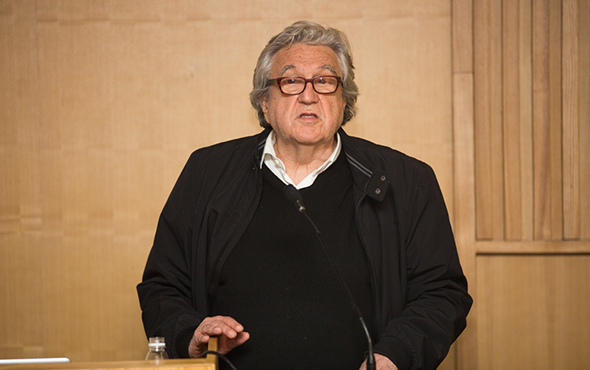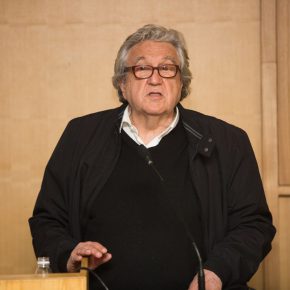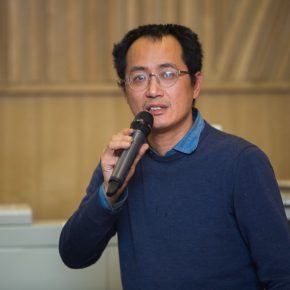
Antoni Muntadas is a famous media artist born in Spain, a founding member of video and installation art. He once taught at the Massachusetts Institute of Technology and the former head of the Department of Arts/Culture/ Technology, and now he teaches in the IUAV, Venice, Italy. At 18:30 on March 17, 2017, Muntadas gave a lecture on the “Art Project – Working in the Process” to the audience at the Red Chair Academic Hall of Building 7, the Central Academy of Fine Arts.
In the first half of the lecture, Muntadas presented the audience with some artists who started the work and which is in the process. Muntadas has always been committed to methods and discussions of long-term art projects and he believed that time was a very important concept for the long-term art project. He said that, “Artists have different methods of artistic creation; some people spend a short time on the creation while some artists spend a long time carrying out a large-scale project. It takes a long time from the germination of an idea to research and the production of works of art.”
Muntadas first introduced the land artist Robert Smithson from the United States, and his works of spiral waves were a kind of classic land art, with shocking power. And then he introduced the classic works of wrapped art by the Christo couple, Muntadas said that: “At the beginning, they started from the wrapped things and when they began to wrap large buildings, it included the long-time economic, political, diplomatic work. It means that art must come out of the white box and deal with society.” “When we speak of art projects, we have to mention Joseph Beuys, whose seven thousand oaks and the independent international university which is also a project about time and life. The artist Hans Haacke was active in New York in the 1970s, and the majority of his works are about the biological evolution and about the process. His works reflect both the process of biological evolution and he gradually embodies the artist’s concern for the evolution of society. And then he introduced the works of Qiu Zhijie, “His work covers the time and research, although many of his masterpieces are fictitious maps, the finishing and research of the thinking logic behind the maps cost a long time. Tehching Hsieh is a Taiwanese artist, and his representative work of performance art – in one year, he focused on the punch card in an art museum, or focused on living in the open air over one year, when he was operating anoutdoor project, we were neighbors, so that I often met Hsieh and witnessed the birth of his art ...”
In addition, Muntadas also introduced the art projects and programs by Hanna, Torres, Paolo Soleri and these artworks include the artists’ long-term unremitting efforts and the thought on time and process. And then he introduced his own art projects and art programs to the audience.
He took “Warning: Perception Requires Involvement” series as an example. The work is a translation of the sentence of “Warning: Perception Requires Involvement” in different languages, translating it into Korean, Arabic, etc., and the use of different mediums including posters, newspapers, building publicities, etc. to present it. Because of the difference between the medium and context, the meaning of the work is different.
The works created by Muntadas in 1989 are a set of carpets embroidered with twelve European countries. On the carpet that is similar to the flag of the EU, there are twelve stars representing the twelve European countries. He believed that the political meaning of this work was rather strong and said that: “It is difficult for us to imagine the feeling of stepping on their own flag, but I think the EU has been established for only a short time, it is a peaceful conclusion, and nobody died for it, so it is wonderful to step on the flag.” This set of works is composed of a total of 12 pieces, placed in public places of 12 countries, including Portugal, Greece, etc., and he can also see the interaction between viewers and works in public places. “It started from a simple draft of a carpet design, to the digital image production and then the use of traditional Belgian craft to produce a carpet, and then to persuade twelve countries to exhibit this artwork, finally persuading the audience and artworks to interact” Muntadas said, “It really took a long time”.
“In the 1980s, the various aspects of the art system gradually matured and this work responded to every link of the art system.” He later introduced a set of work into the museum: the lights of different colors are projected in different rooms of an art Museum, which represents practitioners located in different parts of the art system, and the audience can see the interview of practitioners in different parts in the room.
Muntadas is interested in cultural differences reflected in many works, for example, the work on “translation”. Translation is as an expression for the artist. He spent a lot of time completing this set of works, “translation” is not only about the translation of language, but also on cultural and political translation. Finally, it was through a stitched video work that he showcases “translation”. Taking “Asian Protocol” as an example, the project started from Germany and later transferred to Asia, taking China, Japan and South Korea as the objects for the research of Asian protocol. Muntadas believed that people accepted a set of rituals and rules in various activities and he would like through the “Asian Protocol” project to have a deeper understanding of China, Japan and South Korea, as well as Asia, and it also allows China, Japan and South Korea to mutually reappear and know each other. The project started in 2011, has been moved to Seoul and Tokyo for exhibitions and it will be exhibited in Beijing in 2018.
Text by Zhong Yuwei, translated by Chen Peihua and edited by Sue/CAFA ART INFO
Photo by Yang Yanyuan/CAFA ART INFO


































